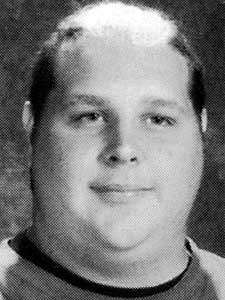|
Audio
Photos
More from MPR
Resources
Your Voice
|
Feds make an example of teenage hacker
August 29, 2003
 |
| Jeffrey Lee Parson, in his 2003 yearbook photo from Hopkins High School. (Hopkins High School yearbook) |
St. Paul, Minn. — Jeffrey Parson faces felony charges for unleashing a variant of the Blaster computer worm, also refered to as the LoveSan virus.
Federal agents in both Seattle and Minnesota helped track Parson down. He didn't write the original Blaster program, but at a press conference in Seattle, U.S. Attorney John McKay said he will be prosecuted aggressively.
"With this arrest we want to deliver a message to cyberhackers here and around the world," McKay said. "As the attorney general of the United State has said, the Department of Justice takes these crimes very seriously. We will devote all available resources to tracking down those who attack our technological infrastructure. Let there be no mistake about it. Cyberhacking is a crime."
 | |||
The original Blaster worm -- a denial of service attack --was aimed at enlisting millions of unwitting computers to contact a particular Microsoft Web site. The resulting volume of contacts is intended to overwhelm the site.
Microsoft had no trouble protecting its own site, but the bug clogged computer networks around the world. Parson is accused of rewriting the worm, so infected computers would send back information to a Web site he operated. Authorities have identified around 7,000 computers affected by Parson's version.
U.S. Attorney Tom Heffelfinger says even though Parson may not have affected millions of computers, his alleged actions pose a serious threat.
"It's important to go after every individual who intentionally inserts a virus into a computer and hurts however many people," Heffelfinger said. "This country is dependent on our computer networks. And when people -- whether it's for financial gain or for their perverted view of fun -- tampers with and destroys our capability to transmit information on the computer, the nation is harmed. This is a serious, serious matter."
 | |||
Parson lives with his mother and father in a white townhouse in Hopkins, southwest of Minneapolis. Parson's neighbor, Kathy Noor, says the six-foot four, 320-pound high school student was a positive influence in the neighborhood.
"There was an incident across the street last year where there was a domestic dispute, where he stopped the guy from hurting the lady," Noor said. "They're nice people. They're not like some people -- they're nice." Friend Nina Baurenfiend says Parson may not have known what he was getting into.
"He said that he sent out a virus and he didn't know what it was going to do exactly, but it was out there and it was modified original," Baurenfiend said.
She also said Parson expressed regret as federal agents closed in on him.
"Like, he felt really bad. When he found out this was a huge thing he felt really bad," she says. "He was freaking out, and we were talking to him, trying to make him feel better, and he just didn't know what to do. He was freaking out and now he's getting caught."
|
It's important to go after every individual who intentionally inserts a virus into a computer and hurts however many people ... this is a serious, serious matter.
- U.S. Attorney Tom Heffelfinger |
Authorities confiscated seven computers from Parson's home. By all accounts, he was attracted to computers and to disruptive programs. He posted questions on Internet sites asking for help with a program that hacks an early type of instant messaging system.
However adept he may have been, Parson left clues in his worm program that made him relatively easy to trace. His online name is "teekid." He used this name in his rewritten Blaster program. In addition, infected computers were instructed to register on his Web site that also used the teekid moniker. Andy Bork heads Techies, a Minneapolis-based corporate computer support service. He says leaving such traces reveals a low level of sophistication in the hacker world.
"If you're doing it out of your own home and you have your own Web site, that's just like robbing a bank and the demand (note) is the deposit slip for your checking account," Bork said. "They know exactly who you are. Especially if they are reporting back to you at that same site."
Dressed in khaki shorts, tennis shoes and a T-shirt, Parson was polite and soft-spoken at his court appearance. Magistrate Judge Susan Nelson ordered him to home detention with electronic monitoring, except for times when he attends school. His next court appearance is Sept. 17 in federal court in Seattle.
|
News Headlines
|
Related Subjects
|
